Definition, Theorem, Formulas, Solved Example Problems | Inverse of a Non-Singular Square Matrix - Properties of inverses of matrices | 12th Mathematics : UNIT 1 : Applications of Matrices and Determinants
Chapter: 12th Mathematics : UNIT 1 : Applications of Matrices and Determinants
Properties of inverses of matrices
Properties of inverses of matrices
We state and prove some theorems on non-singular matrices.
Theorem 1.4
If A is
non-singular, then

, where ╬╗ is a
non-zero scalar.
Proof
Let A be non-singular. Then |A| ŌēĀ 0 and AŌłÆ1 exists. By
definition,
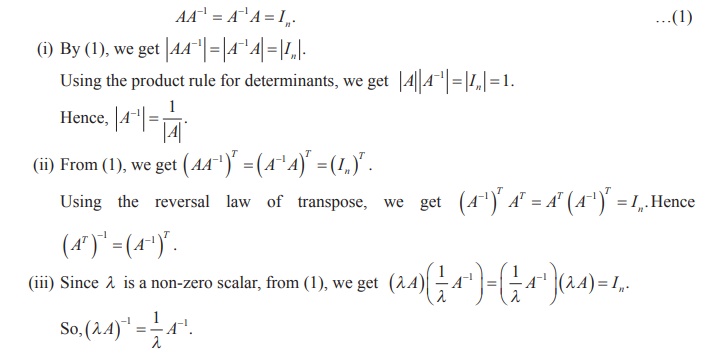
Theorem 1.5 (Left Cancellation Law)
Let A, B, and C be square matrices of order
n. If A is non-singular and AB = AC, then B = C.
Proof
Since A is non-singular, AŌłÆ1 exists and AAŌłÆ1 = AŌłÆ1 A = In .
Taking AB = AC and pre-multiplying both sides by AŌłÆ1, we get AŌłÆ1 ( AB) = AŌłÆ1 ( AC). By
using the associative property of matrix multiplication and property of inverse
matrix, we get B = C.
Theorem1.6 (Right Cancellation Law)
Let A, B, and C be square matrices of order
n. If A is non-singular and BA = CA, then B = C.
Proof
Since A is non-singular, AŌłÆ1 exists and AAŌłÆ1 = AŌłÆ1 A = In .
Taking BA = CA and post-multiplying both sides by AŌłÆ1, we get (BA) AŌłÆ1 = (CA) AŌłÆ1. By using the
associative property of matrix multiplication and property of inverse matrix,
we get B = C.
Note
If A is singular and AB = AC or BA = CA, then B and
C need not be equal. For instance, consider the following matrices:

We note that |A| = 0 and AB = AC ; . but B ŌēĀ C
Theorem
1.7 (Reversal Law for Inverses)
If A and B are
non-singular matrices of the same order, then the product AB is also
non-singular and ( AB)ŌłÆ1 = BŌłÆ1 AŌłÆ1.
Proof
Assume that A and
B are non-singular matrices of same order n. Then,| A | ŌēĀ 0, | B | ŌēĀ 0, both AŌłÆ1 and BŌłÆ1 exist and they are of
order n. The products AB and BŌłÆ1 AŌłÆ1 can be found and they
are also of order n. Using the product rule for determinants, we get |AB|
=| A || B |ŌēĀ 0. So, AB is
non-singular and
( AB)(B-1 A-1 ) = ( A(BB-1 )) A-1
= ( AIn ) A-1 = AA-1 = In ;
(B-1 A-1 )( AB) = (B-1 ( A-1
A))B = (B-1In )B = B-1B = In .
Hence ( AB)ŌłÆ1 = BŌłÆ1 AŌłÆ1.
Theorem
1.8 (Law of Double Inverse)
If A is
non-singular, then AŌłÆ1 is also non-singular and ( AŌłÆ1 )ŌłÆ1 = A.
Proof
Assume that A is non-singular. Then |A | ŌēĀ 0, and AŌłÆ1 exists.
Now, |A-1| = 1/|A| ŌēĀ 0
ŌćÆ A-1 is also non-singular, and AA-1
= A-1A = I
Now, A-1A = I ŌćÆ (AA-1)-1 = I ŌćÆ (A-1)-1
A-1 = I.
Post-multiplying
by A on both sides of equation (1), we get (A-1)-1
=A.
Theorem 1.9
If A is a non-singular square matrix of order n ,
then

Proof
Since A is a non-singular square matrix, we have |A| ŌēĀ 0 and so, we get
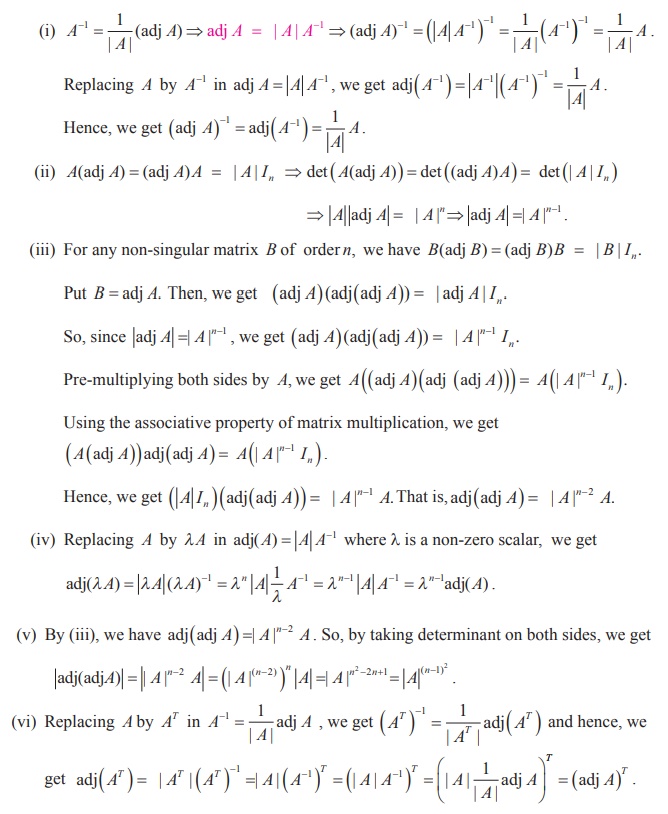
Note
If
A is a non-singular matrix of order
3, then, |A | ŌēĀ 0 . By theorem 1.9 (ii), we get |adjA| = | A|2 and
so, | adj A | is positive. Then, we get |A| = ┬▒ ŌłÜ|adjA| .
So,
we get 
Further,
by property (iii), we get 
Hence,
if A is a non-singular matrix of order 3, then we get 
Example 1.4
If A is a non-singular matrix of odd order, prove that |adj
A| is positive.
Solution
Let A be a non-singular matrix of order 2m + 1 , where m = 0,1, 2,
.. . . Then, we get |A| ŌēĀ 0 and, by theorem 1.9 (ii), we have |adj A| = |A|(2m+1)-1
= |A|2m
Since |A|2m is always positive, we get that |adj A| is
positive.
Example 1.5
Find a matrix A if adj( A) = 
Solution

Example 1.6
If adj A = find AŌłÆ1.
find AŌłÆ1.
Solution
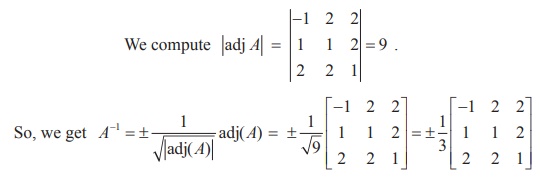
Example1.7
If A is symmetric, prove that adj A is also
symmetric.
Solution
Suppose A is symmetric. Then, AT = A and so, by theorem
1.9 (vi), we get
adj (AT) = (adj A) T ŌćÆ adj A =
(adj A)T ŌćÆ adj A is symmetric
Theorem
1.10
If A and B are
any two non-singular square matrices of order n , then
adj( AB) = (adj B)(adj A).
Proof
Replacing A by AB in
adj(A) = |A|AŌłÆ1 , we get
adj(AB) = |AB| (AB)-1 = (| B | B-1) (| A | A-1)
= adj(B) adj(A)
Example 1.8
Verify the property ( AT )ŌłÆ1 = ( AŌłÆ1 )T with A =  .
.
Solution
For the given A, we get |A |= (2) (7) - (9)(1) = 14 ŌłÆ 9 = 5 .
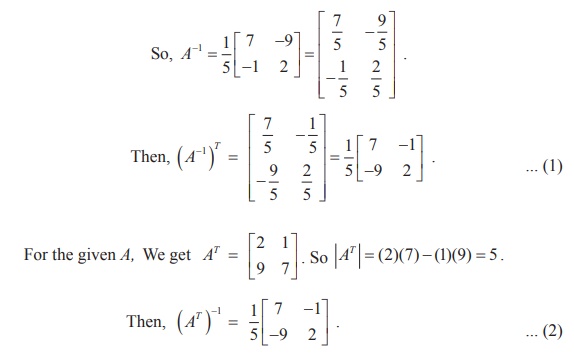
From
(1) and (2), we get (A-1) = (AT)-1. Thus, we
have verified the given property.
Example 1.9
Verify ( AB)ŌłÆ1 = BŌłÆ1 AŌłÆ1 with 
Solution
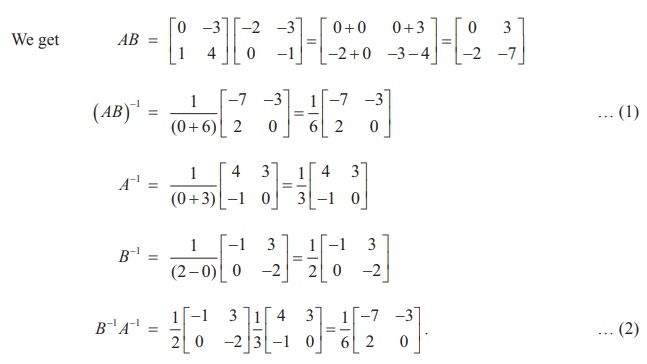
As
the matrices in (1) and (2) are same, (AB) ŌłÆ1 = B-1 A-1
is verified.
Example 1.10
If A =  , find x and y
such that A2 + xA + yI2=O2, Hence, find AŌłÆ1.
, find x and y
such that A2 + xA + yI2=O2, Hence, find AŌłÆ1.
Solution

So,
we get 22 + 4x + y =0, 31+5x+y=0, 27+3x=0 and 18+2x=0
Hence
x = ŌłÆ9 and y =14.Then, we get A2 - 9A + 14I2 = O2
Post-multiplying
this equation by AŌłÆ1 , we get A ŌĆō 9I2 + 14A-1
= O2. Hence, we get

Related Topics